Punjab Irrigation Department
Punjab Irrigation Department (Urdu: پنجاب محکمہ آب پاشی), Pakistan, is a provincial irrigation department in the Punjab province of Pakistan.[1] Punjab Irrigation Department irrigates 21 million acres of agricultural land in Punjab.[2] Muhammad Mohsin Leghari, an MPA from Rajanpur, is the Minister for Irrigation.[3] Secretary Irrigation to the government of the Punjab is the administrative head of the department.
punjab.gif) | |
| Government organization | |
| Industry | Water Resource Management |
| Headquarters | Lahore |
Area served | 21 Million Acres |
| Services | Water Resource Management |
Number of employees | 35,000 |
| Divisions | 6 Operational Zones - Lahore, Faisalabad, Multan, Sargodha, Bahawalpur and DG Khan |
| Website | https://irrigation.punjab.gov.pk/ |
History
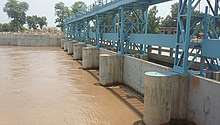
The Indus Basin has a long history of irrigation dating back to 4000 year old Indus valley civilization in Harrapa and Mohenjodaro settlements.[4] At the time, irrigation in the region was done mainly through inundation canals. The history of modern Punjab Irrigation Department can be traced back to the establishment of 5 major canals in the region in early 20th century when the British built Lower Chenab Canal, Lower Jhelum Canal, Upper Jhelum Canal, Upper Chenab Canal and Lower Bari Doab Canal.[5]
The Indus Waters Treaty which was signed between India and Pakistan in 1960 was a major watershed in the history of development of irrigation infrastructure in the province.[6] The treaty gave the rights of the three eastern rivers of the Indus basin namely Ravi, Sutlej and Beas to India and thus necessitated the construction of inter river link canals to haul water from Indus, Jhelum and Chenab to the eastern parts of the province. It was after this treaty that Pakistan built Tarbela and Mangla reservoirs to store monsoon water for winter months to continue to irrigate the fields year round.
The second major development post independence in the history of irrigation in Punjab was 1991 Water Accord between all the four provinces of Pakistan. This accord gave Punjab province 55.94 million acre feet of water share annually for its irrigation and drinking usages.[7] It is with this share that the Punjab Irrigation Department caters to its 21 million acres of command area in the province.
Services
Punjab Irrigation Department is responsible for delivering the following services in the province:[8]
- Provision of irrigation supplies to farmers
- Construction, maintenance and operation of irrigation infrastructure
- Flood planning and management
- Basic and applied research in hydraulics, groundwater and land reclamation
- Construction of reservoirs
- Vertical and surface drainage
- Management of workshop and machinery pool
Barrages
Punjab Irrigation Department Manages the following barrages:[9]
- Jinnah Barrage on River Indus[10]
- Taunsa Barrage on River Indus [11]
- Rasul Barrage on River Jhelum [12]
- Marala Headworks on River Chenab[13]
- Qadirabad Barrage on River Chenab[14]
- New Khanki Barrage River Chenab[15]
- Balloki Barrage on River Ravi[16]
- Trimmu Barrage on River Chenab[17]
- Sidhnai Barrage on River Ravi[18]
- Islam Barrage on River Sutlej [19]
- Suleimanki Barrage on River Sutlej[20]
- Panjnad Barrage on River Indus[21]
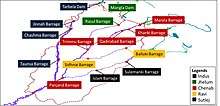
Zones
For the purpose of administration and management the Punjab irrigation system is divided into the following 6 operational zones:[22]
Lahore Zone
There are following operational circles in Lahore Zone:[23]
- Upper Chenab Canal Circle
- Depalpur Canal Circle
- Link Canal Circle
- Lahore Drainage Circle
- Development Circle
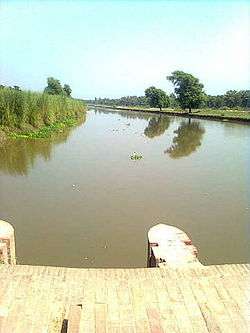
Faisalabad Zone
There are following operational circles in Faisalabad Zone:[24]
- Lower Chenab Canal East Circle
- Lower Chenab Canal West Circle
- Drainage Circle
- Qadirabad Balloki Link Canal Circle
- Development Circle
Sargodha Zone
There are following operational circles in Sargodha Zone:[25]
- Upper Jhelum Canal Circle
- Lower Jhelum Canal Circle
- Thal Canal Circle
- Drainage Circle
Multan Zone
There are following operational circles in Multan Zone:[26]
- Nilibar Circle
- Haveli Canal Circle
- Development Circle
- Mailsi Canal Circle
Bahawalpur Zone
There are following operational circles in Bahawalpur Zone:[27]
- Bahawalpur Canal Circle
- Bahawalnagar Canal Circle
- Rahimyarkhan Canal Circle
- Development Circle
DG Khan Zone
There are following operational circles in Dera Ghazi Khan Zone:[28]
- Derajat Circle
- Muzaffargarh Canal Circle
- Project Circle
Each operational zone is headed by a chief engineer and each circle is headed by a superintending engineer and they are supported by an extended team of executive engineers, sub-divisional officers, sub-engineers, mates and baildars. In addition to operational zones, the department has following zones for overall planning and management of irrigation operations:
- Planning and Review Zone
- Drainage and Flood zone
- Research zone
- Development zone
Punjab Irrigation Department also manages Government Engineering Academy Punjab which provides pre-service and in-service training to irrigation engineers.[29]
Service Delivery
Punjab Irrigation Department delivers irrigation supplies to farmers through 51,990 outlets in its system of 24 main canals and distribution canals spanning 22,700 kilometers.[30]
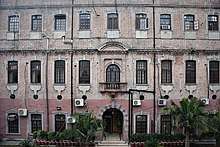
The Punjab Irrigation Department has its head office in Old Anarkali, Lahore.[31] Punjab Irrigation Department has complaint hotline 0800 11 333 for registration of complaints regarding irrigation supply issues.[32] Daily canal discharges at all the canals in the entire system can be checked at the official website of the department.[33]
Units
For the purpose of management of various projects and institutional reforms the Punjab Irrigation Department has established the following Units:[34]
Laws and policies
Punjab Irrigation Department functions under Canal and Drainage Act 1873 which was introduced to regulate irrigation, navigation and drainage of provincial territories. The purpose of this act is that the Provincial Government is entitled to use and control for public purposes, the water of all rivers and streams flowing in natural channels, and of all lake and other natural collections of still water in said territories[37]. An amendment was made in Canal and Drainage Act in 2016[38]. In 2019, the Government introduced Punjab Water Act 2019 to regulate the usage of surface and groundwater in the province[39].
Major developments
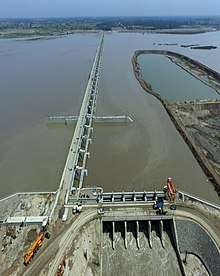
In 2010-11 completed the Taunsa Barrage rehabilitation and modernization project with cost of Rs. 11 billion rupees.[40] Punjab Irrigation Department Completed the Punjab Irrigation completed the construction of New Khanki Barrage in August 2017 which replaced the old Khanki Headworks which irrigated 3.03 million acres of fertile land in 8 districts of central Punjab.[41]
Punjab Irrigation Department has, in December 2019, inaugurated the construction of Jalalpur Irrigation Canal System.[42] The 117 kilometer long canal will originate from River Jhelum at Rasul Barrage and, along with its branches, will irrigate 1,70,000 acres of arid land in Districts of Jhelum and Khushab. The Department has also initiated works on Dadocha Dam which will supply 35 million gallons of drinking per day to the people of Rawalpindi.[43] In addition to this civil works on projects like Rehabilitation of Trimmu and Panjnad Barrages, rehabilitation of Trimmu-Sidhnai Canal, SMB Link Canal, Ahmadpur Branch and Eastern Sadiqia Canal are also underway and expected to be completed by 2022.
On 22 May 2019, Punjab Khal Panchayat Authority was established under the Punjab Khal Panchayat Ordinance 2019 to ensure implementation of warabandi minimizing the water disputes and distribution.[44][45] This authority replaced the erstwhile Punjab Irrigation and Drainage Authority (PIDA).
References
- Ul Haq, Asrar. "Case Study of the Punjab Irrigation Department" (PDF). International Water Management Institute. Retrieved 15 April 2020.
- Farooqi, Monem. "Punjab irrigation M&R backlog reaches Rs600 billion".
- "Punjab's 23-member cabinet sworn in". Pakistan Today. August 27, 2018. Retrieved April 15, 2020.
- Alam, U. "Irrigation in the Indus basin: A history of unsustainability?". Water Science and Technology Water Supply. 7 – via Researchgate.
- Douie, James (1914). "The Punjab Canal Colonies". Journal of the Royal Society of Arts. 62 (3210): 611–623. JSTOR 41341616.
- "Fact Sheet: The Indus Waters Treaty 1960 and the Role of the World Bank". The World Bank. June 11, 2018. Retrieved February 4, 2020.
- "Indus River System Authority". Retrieved February 4, 2020.
- Ul Haq, Asrar. "Case Study of the Punjab Irrigation Department" (PDF). International Water Management Institute. Retrieved April 15, 2020.
- "PUNJAB BARRAGE REHABILITATION & MODERNIZATION PROJECT" (PDF). Retrieved 13 January 2019.
- "Making the Desert Bloom: Jinnah Barrage". The World Bank. January 28, 2013. Retrieved April 15, 2020.
- "Taunsa Barrage a Lifeline for Millions". The World Bank. September 8, 2012. Retrieved April 15, 2020.
- "Rasul Barrage".
- "Marala Headworks". Wikipedia. March 15, 2020.
- "Remodeling of LMB of Qadirabad Barrage in Critical Reaches" (PDF).
- Abbas, Hassan (May 2, 2019). "New Khanki Barrage Wazirabad: 'DESCON completes construction in record 50 months". Business Recorder. Retrieved April 15, 2020.
- "Lower Bari Doab Canal Improvement Project (LBDCIP)". Lower Bari Doab Canal Improvement Project (LBDCIP).
- "Trimmu Barrage".
- "Flood Fighting Plan 2011" (PDF). UNESCO Office in Islamabad.
- "Islam Barrage".
- "Sulemanki Headworks". Wikipedia.
- Gill, Majeed (7 November 2018). "Panjnad headworks rehabilitation project begins". Dawn. Retrieved 13 January 2019.
- "Irrigation Department Punjab". Irrigation Department Punjab.
- "Introduction Of Lahore Irrigation Zone". Punjab Irrigation Department. Retrieved January 30, 2020.
- "Introduction Of Faisalabad Irrigation Zone". Retrieved January 30, 2020.
- "Introduction of Sargodha Irrigation Zone". Punjab Irrigation Department. Retrieved January 30, 2020.
- "Introduction Of Multan Irrigation Zone". Retrieved January 30, 2020.
- "Introduction of Bahawalpur Irrigation Zone". Retrieved January 30, 2020.
- "Introduction Of D G Khan Irrigation Zone". Retrieved January 30, 2020.
- "Government Engineering Academy Punjab".
- Riaz, Khalid. "Water and Irrigation in Punjab" (PDF). Pakistan Institute of Development Economics. Retrieved 23 January 2020.
- "Irrigation Department Punjab".
- "Program Monitoring and Implementation Unit".
- https://irrigation.punjab.gov.pk/
- "Irrigation Department Punjab".
- "Project Management Office Canals". Irrigation Department Punjab.
- "PMO Punjab Barrages".
- "Canal and Drainage Act, 1873 (Act VIII of 1873)". ECOLEX.
- "CANAL AND DRAINAGE (AMENDMENT) ACT 2016". Punjab Code.
- "Punjab Water Act 2019". Punjab Codes.
- Chaudary, Zulfiqar. "Rehabilitated Taunsa Barrage: Prospects and Concerns". Science and Technology Development.
- Gilani, Iqtidar. "Descon to hand over New Khanki Barrage to Irrigation Dept in June".
- "Jalalpur Canal to benefit people: CM Usman Buzdar". The News. 28 December 2019. Retrieved 23 January 2020.
- Mehmood, Amjad (1 January 2020). "Irrigation dept claims credit for executing key projects in 2019". Dawn. Retrieved 23 January 2020.
- "PIDA abolished: Irrigation dept takes control of canals, watercourses". Dawn. May 25, 2019. Retrieved March 6, 2020.
- "PA passes Punjab Water Bill 2019 amid opposition's boycott". Business Recorder. November 21, 2019. Retrieved March 6, 2020.